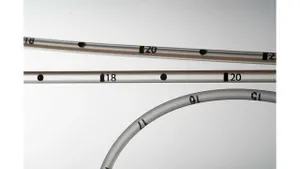Plastics processing: A five-step program to improve profits and optimize production
As executives, managers and employees leverage their focus on everything from growing sales to maximizing production efficiency and capacity, they often neglect these five areas, which can negate many, if not all, of their other efforts.
September 27, 2017

 Successful plastics processors want to constantly improve production capacity, maintain quality standards and grow profit margins while continuing to provide the superior service that ensures repeat business. How can they attain that level of control over their businesses and consistently make the decisions that best support their companies’ continued success?
Successful plastics processors want to constantly improve production capacity, maintain quality standards and grow profit margins while continuing to provide the superior service that ensures repeat business. How can they attain that level of control over their businesses and consistently make the decisions that best support their companies’ continued success?
Plastics processors require access to relevant, current data and the ability to run reports that clearly demonstrate specific trends. This allows them to identify challenges and wins, then plan accordingly and take the appropriate actions. For example, they need to be aware of actual material consumption and regularly compare production efficiency and profitability against established standards if they are to make the necessary adjustments before they veer too far off course.
Yet as executives, managers and employees leverage their focus on everything from growing sales to maximizing production efficiency and capacity, they often neglect these five areas, which can negate many, if not all, of their other efforts.
1. Establish and monitor both daily and weekly KPIs
Simplified, accurate data is indispensable to support a growth strategy and improve margins and performance.
Executives, managers and employees must see progress toward targets such as AP/AR, sales, cash flow, inventory, production and quality. They also need to be aware of negative trends to reach a decision and take appropriate action.
Identify the performance indicators that most effectively track your company’s long-term sustainability. Ensure executives and managers can easily monitor those KPIs and are able to create the reports that allow them to assess the state of the business. Software can be pre-programmed to run the most relevant reports on a weekly, monthly or quarterly basis and manage employee access to ensure security and privacy. Effective systems offer report summaries and at-a-glance dashboards that quickly show senior leaders exactly what’s going on.
2. Compare standard and actual daily production cost variances
Cost variances are instrumental in identifying issues with certain products and product categories. They can also help pinpoint issues with certain equipment, individual employees and shifts. Much like in production-time benchmarking, it’s important to continuously compare standard versus actual production costs, including everything from raw materials to downtime, setup time, repair and maintenance and overtime.
Significant cost variations may indicate that standard production times and labor or material costs need to be updated or that the setup times and scrap/waste ratios are inaccurate.
Processors that can run a cost analysis on every job for each shift can track production efficiency and take action on underperforming equipment, tools and material in a timely manner.
With job-by-job data, processors can run accurate weekly, monthly, quarterly and annual cost analyses to obtain an outstanding overall perspective on the efficiency and profitability of the processing operations. They are then able to respond accordingly, whether it’s adjusting a selling price, seeking a new material supplier or providing additional training.
3. Update and maintain SKU standards
Benchmarking products with standard labor and material costs, machine times (which vary from machine to machine) and overhead is crucial for processors that want to accurately establish production times, track costs, quote on jobs and create price lists.
Do you regularly and carefully review your previously established standards? Do you do this as frequently as is actually necessary?
In reality, because reviews are considered time-intensive and strictly cost accounting tasks, they are rarely performed as frequently as is necessary, although they are an effective exercise in discipline and control.
Plastics processors that invest the time and effort will see if production times have deteriorated or improved, whether resin price increases have further diminished margins and if setup times and scrap ratios have shifted.
Methodically revisiting products and standards ensures processors will minimize and even avoid repeating the mistakes that negate their process improvement initiatives.
Accurate, frequent and consistent costing provides the solid foundation on which successful processors can build profitable, efficient businesses.
4. Failing to cycle inventory right from the production line
Businesses require immediate access to live inventory information for effective management—waiting days, weeks or even months while data is manually compiled into reports puts companies at a real disadvantage. Such delays reduce the ability to link rejects and inefficiencies to specific parts and work orders before it affects more than profit margins.
Effective, results-oriented inventory management requires recipe and formula reviews to accurately forecast material requirements. Collecting and tracking material usage in real time enables inventory analysis and decision making.
These factors all affect deviations from established standards: Setup times, purges, defects, scrap/waste and alternate recipes that leverage in-stock material or regrind.
Order entry, planning and purchasing all require accurate, actionable information from the shop floor. Without it, employees are unable to confidently optimize production capacity and minimize downtime. As importantly, without that information, it’s virtually impossible to accurately balance stock or rely on existing inventory counts without manual, physical counts, all of which makes it more difficult to enhance service and scale the business.
5. Integrating material requirement planning with purchasing
Obviously, inventory levels affect a company’s cash flow, whether it’s raw material or finished product sitting idle. That cash would be more effective if invested elsewhere, for example in equipment or other improvements, while also augmenting overheads such as storage space.
Ideally, inventory levels should be as low as possible without adversely affecting product and deliveries if the raw material or finished products aren’t available when required. Good data, historical reports, accurate forecasts and experience all contribute to achieving the right balance.
When material is tracked and controlled at the production level, accurate materials requirement planning data is immediately available to purchasing. This alerts purchasing employees to material allocation alterations due to new orders, changes to the production schedule or excessive rejects.
Effectively integrating purchasing and global material allocation will enable and facilitate true just-in-time strategies, while reducing stress, improving cash flow and profitability. Operating costs, such as storage and freight, could also be reduced.
Bonus point: Manage regrind to boost the bottom line
In the plastics processing industry, regrind is a given because it’s technically impossible to achieve the perfection required to completely eliminate waste.
Engineering and tool optimization are the first steps toward reducing the waste generated during molding and extrusion. Expensive, sophisticated hot-runner equipment offers an alternative to manufacturing waste reduction.
To minimize the demand for virgin material, scrap can be reground for use as a raw material, immediately returned to the hopper or sold to a recycler.
Ideally, regrind is immediately classified and returned to inventory so that it’s visible and available for reuse in a production recipe. If employees don’t know it’s there or it’s incorrectly classified, additional material is unnecessarily ordered and production costs increase although that’s rarely, if ever, reflected in the prices customers pay.
 Rick Dunne is Director of Sales at CyFrame International Enterprises, a provider of enterprise resource planning (ERP) and business management software for plastics processors. Dunne specializes in helping plastics processors improve production efficiency and profitability through industry-specific ERP.
Rick Dunne is Director of Sales at CyFrame International Enterprises, a provider of enterprise resource planning (ERP) and business management software for plastics processors. Dunne specializes in helping plastics processors improve production efficiency and profitability through industry-specific ERP.
About the Author(s)
You May Also Like


